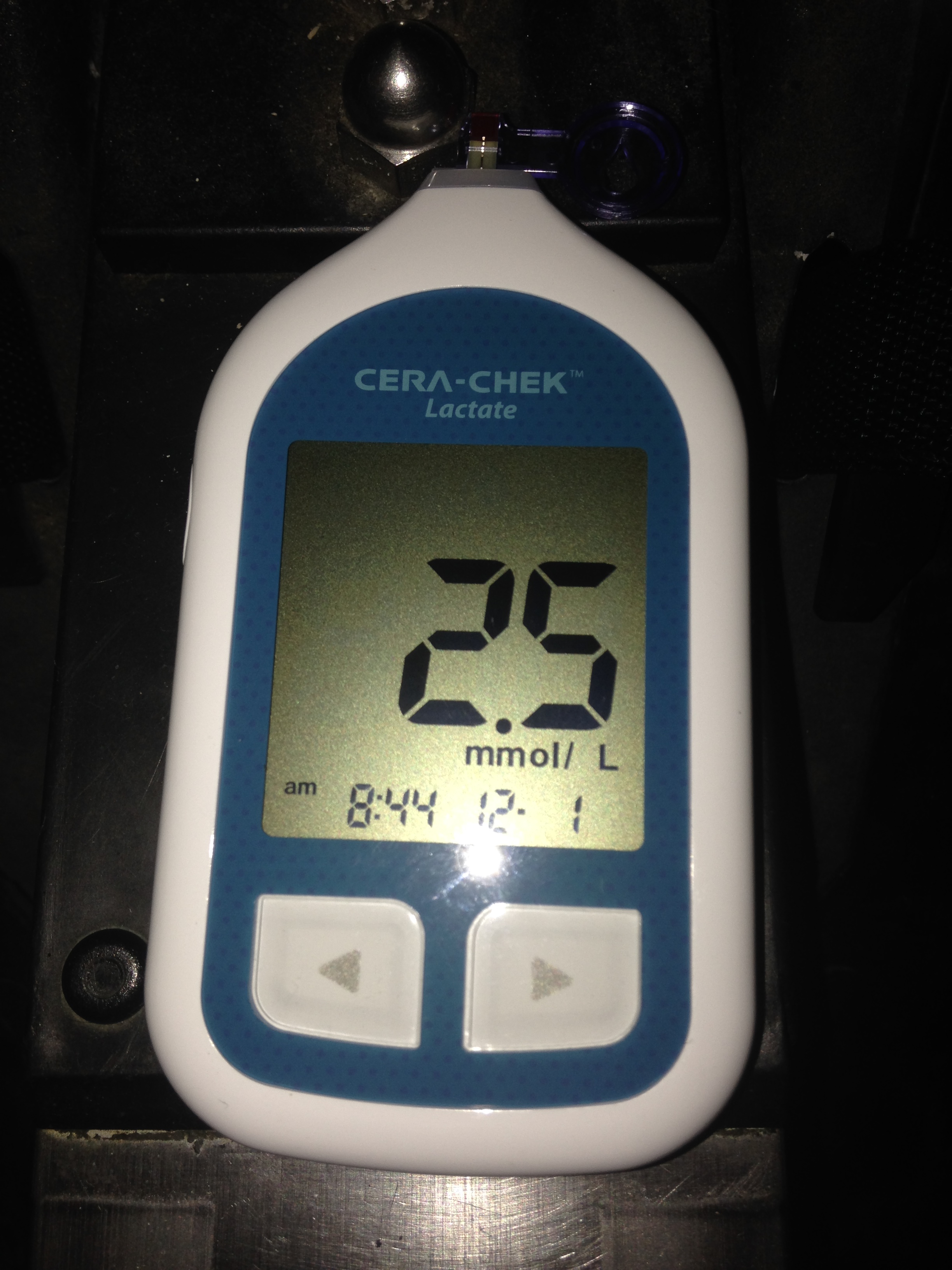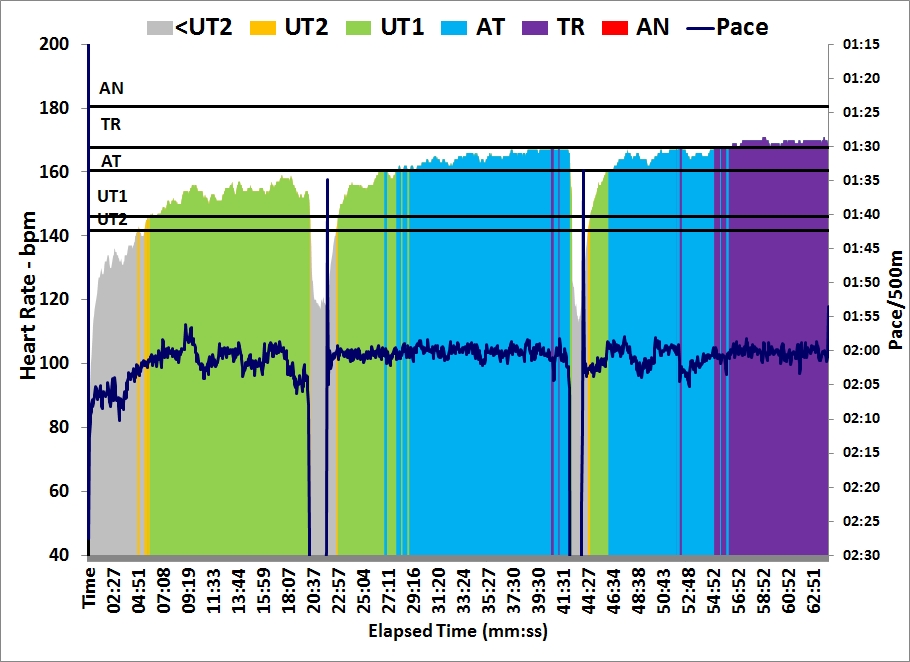Today I ignored lesson 1 for steady state sessions. If it is supposed to be a UT2 or UT1 session, it is not supposed to feel like hard work. If it does, you should back down, reduce the intensity, or even just stop and take a rest day.
For science (or rather for my curiosity as my method lacks scientific rigor), I pushed on.
A lot of things were different today, compared to the steady state sessions that I measured lactate on so far:
- I didn’t sleep well. I woke up from a dream which I could remember quite vividly, which doesn’t happen very often. It was 3AM. Between 3AM and 6AM I was turning in bed, not sleeping well.
- I cycled to work. Made a point of cycling very lightly, “to get yesterday’s heavy session out of my system”.
- I had a big cold salad for lunch, then nothing for the entire afternoon, and for dinner I decided to add an omelet to my usual light dinner.
- The weather has changed from nice, cold and dry to 10 degrees C, rainy and humid.
- It is not November any more.
I did a 3×20 min tonight with a lactate measurement after the last 20 minute interval.
I warmed up for 5 minutes.
First interval didn’t feel too bad. I slowly ramped up the power for the first 10 minutes and ended up doing a 190W on average.
I rowed the second interval with an eye on the clock. It seemed endless. I knew I was working harder than I want to work in steady state sessions, but after 10 minutes funnily the pace started to drift to 210W and I had to consciously keep it down. Still, my breathing and the feeling in my legs told me I was working too hard.
The third interval was hard. The kind of annoying steady state “hard”. It just took too much mental effort to hold the pace. I did some stroke rate changes in the first 10 minutes just to keep the focus. Took a lactate measurement immediately after the interval:

Feeling confirmed. I was actually very happy about this result. It gives me more confidence in lactate measurement as a method to confirm what the perceived rate of effort tells me. And thus it also gives me confidence to continue doing what I have done so far: If it feels too hard, back down.
I’ll start keeping my lactate readings, together with notes on heart rate, perceived level of effort and some other parameters in a spreadsheet.
Here’s the HR plot of the session:

Workout Summary - Dec 01, 2015
--|Total|-Total-|--Avg--|-Avg-|Avg-|-Avg-|-Avg
--|Dist-|-Time--|-Pace--|Watts|SPM-|-HR--|-DPS
--|15428|64:00.0|02:04.5|181.6|22.2|156.9|10.9
Workout Details
#-|SDist|-Split-|-SPace-|Watts|SPM-|AvgHR|DPS-|Comments
01|04902|20:00.0|02:02.4|190.9|21.1|147.2|11.6|1st 20 min
02|00345|02:00.0|02:53.7|066.8|17.5|124.5|09.9|rest
03|04990|20:00.0|02:00.2|201.3|23.3|161.2|10.7|2nd 20 min
04|00220|02:00.0|04:33.0|017.2|13.0|127.9|08.5|rest
05|04971|20:00.0|02:00.7|199.0|23.5|165.4|10.6|3rd 20 min: 2.5 mmol/L
HR drift was 7%.
Follow me in social media
Like this:
Like Loading...
Dec 1 2015
Another Steady State Data Point
Today I ignored lesson 1 for steady state sessions. If it is supposed to be a UT2 or UT1 session, it is not supposed to feel like hard work. If it does, you should back down, reduce the intensity, or even just stop and take a rest day.
For science (or rather for my curiosity as my method lacks scientific rigor), I pushed on.
A lot of things were different today, compared to the steady state sessions that I measured lactate on so far:
I did a 3×20 min tonight with a lactate measurement after the last 20 minute interval.
I warmed up for 5 minutes.
First interval didn’t feel too bad. I slowly ramped up the power for the first 10 minutes and ended up doing a 190W on average.
I rowed the second interval with an eye on the clock. It seemed endless. I knew I was working harder than I want to work in steady state sessions, but after 10 minutes funnily the pace started to drift to 210W and I had to consciously keep it down. Still, my breathing and the feeling in my legs told me I was working too hard.
The third interval was hard. The kind of annoying steady state “hard”. It just took too much mental effort to hold the pace. I did some stroke rate changes in the first 10 minutes just to keep the focus. Took a lactate measurement immediately after the interval:
Feeling confirmed. I was actually very happy about this result. It gives me more confidence in lactate measurement as a method to confirm what the perceived rate of effort tells me. And thus it also gives me confidence to continue doing what I have done so far: If it feels too hard, back down.
I’ll start keeping my lactate readings, together with notes on heart rate, perceived level of effort and some other parameters in a spreadsheet.
Here’s the HR plot of the session:
Workout Summary - Dec 01, 2015
--|Total|-Total-|--Avg--|-Avg-|Avg-|-Avg-|-Avg
--|Dist-|-Time--|-Pace--|Watts|SPM-|-HR--|-DPS
--|15428|64:00.0|02:04.5|181.6|22.2|156.9|10.9
Workout Details
#-|SDist|-Split-|-SPace-|Watts|SPM-|AvgHR|DPS-|Comments
01|04902|20:00.0|02:02.4|190.9|21.1|147.2|11.6|1st 20 min
02|00345|02:00.0|02:53.7|066.8|17.5|124.5|09.9|rest
03|04990|20:00.0|02:00.2|201.3|23.3|161.2|10.7|2nd 20 min
04|00220|02:00.0|04:33.0|017.2|13.0|127.9|08.5|rest
05|04971|20:00.0|02:00.7|199.0|23.5|165.4|10.6|3rd 20 min: 2.5 mmol/L
HR drift was 7%.
Follow me in social mediaShare this:
Like this:
By sanderroosendaal • Uncategorized • 5 • Tags: concept2, erg, lactate, OTE, rowing, steady state, test, testing, training